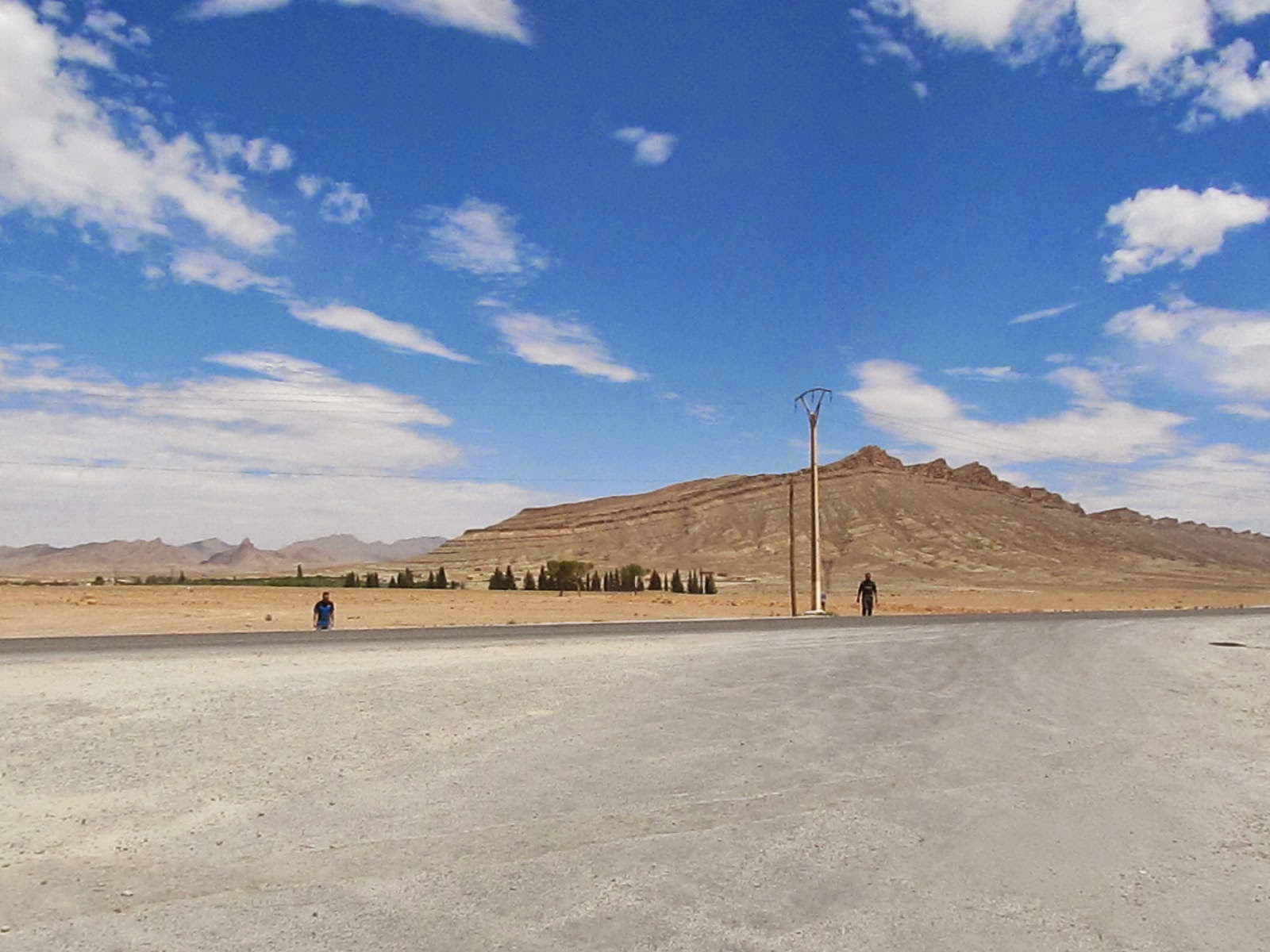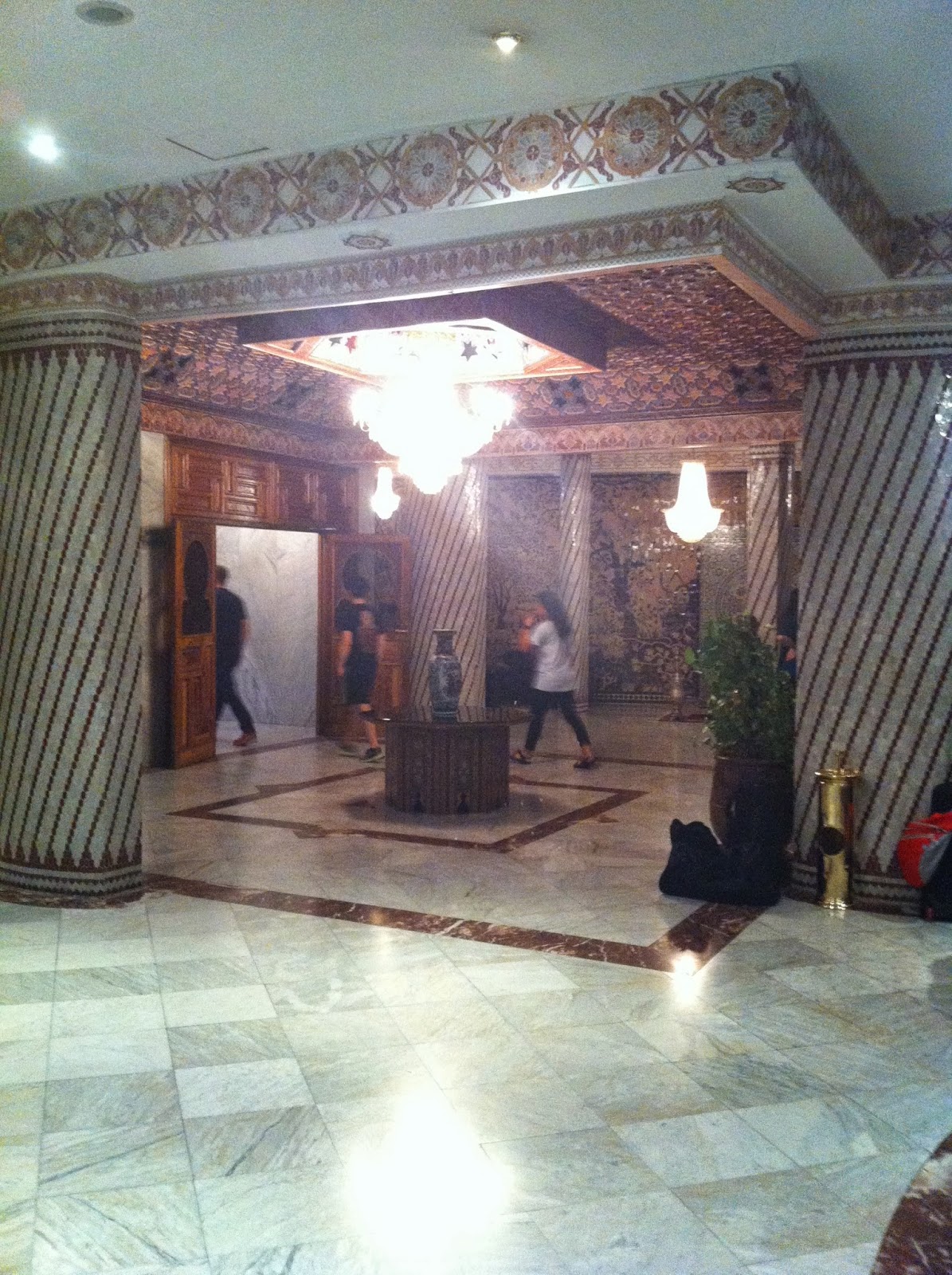We left the hotel in Fes very early in the morning and spent nearly the entire day in the bus driving to the desert. I didn't mind this though- this might sound really stupid but I've always wondered when deserts started. Like when did the green stop and the sand start? It sounds like such a simple question but really it has puzzled me for the longest time, and through the six hours that it took us to arrive in the desert I was able to understand that the change is extremely gradual. Sometimes I thought "oh wow I'm definitely in the desert now" only to round a corner and be faced with lots of low shrubbery. The landscape changed slowly from lush field and rolling hills, to a rocky desert sort of like Arizona in the US, and eventually to the leaping sand dunes that one pictures when thinking of the Sahara desert.
We stopped for lunch in one of the coolest places I've ever been- the Ziz Oasis. In the English language I feel like the term "oasis" is used more as a figure of speech than anything, but this was a true oasis. In the middle of sand and stone and heat and nothingness, there was suddenly a ravine filled with palm trees and other trees and shrubs of the most rich deep green. It's so curious how these things naturally occur, but really that's what makes them so fascinating to experience in person.
After the long drive, we had about another hour and a half drive in Jeep 4x4s across the desert, which was one of the coolest things I've ever done. It was so exhilarating to have the feeling of flying across the open landscape with no set road to follow, even if I was crammed against the very back window in a Jeep with seven other people in it and a driver who spoke no language that the rest of us did. Thankfully enthusiasm has no language barrier, and he sped up and dodged around the other Jeeps as we cheered him on and pushed him to be the first Jeep. The first Jeep to where? We weren't quite sure, but that was okay. We were in the Sahara, and there was nothing in our way.
All the Jeeps pulled up next to one another in a straight line, and we thought for sure that they were lining up for an official drag race (is that the right word?) but we were wrong. As it turned out, the drivers stopped for our benefit and it was even better than a drag race. Our drivers stopped so that we could fully experience and appreciate our first Sahara desert sunset.
Our camp consisted of a bunch of low-ceilinged tents that wrapped around to create a square of sand in the middle. Inside the tents were rows of mattresses on the ground with sheets and blankets, which is where we slept. The beds were actually quite comfortable, however everything was absolutely covered in sand. Even while we were sleeping the sand would blow in through the doors and across our faces and into our sheets. Outside of the square created by our sleeping tents was a large open tent where we ate our meals and hung out during our free time Monday afternoon. There were also stalls for bathrooms, but they didn't work well, and we were encouraged to rather "find our favorite dune" instead of use these bathrooms.
The next day was the absolute best of our trip- the day that we finally got to ride our camels. The camels were tied together in a lines each consisting of about six camels. We were led by guides about an hour through the rolling sand dunes that compose the Sahara landscape. When I studied in Chile, I was lucky enough to ride a horse for the first time, and I had the crazy idea that riding this camel would be a similar experience. Little did I know how wrong I would be. See camels have this inconvenient hump, and that combined with their awkwardly bendy legs creates a rocking effect worse than a little rowboat in a sea storm.
We walked our camels to the largest sand dune in the desert for as far as we could see- this thing was absolutely massive. I can't even begin to imagine how tall it was. There were a bunch of little Moroccan boys playing at the top, and our guides encouraged us to scale the mountainous sand dune for the view from the top. Never in my life did I actually think that I would be transformed into SpiderMan for a few minutes, but that's exactly how I felt. The sand dune was almost exactly vertical, and we crawled up it on our hands and knees. If I thought going up was bad, I was absolutely terrified when it came time to slide down again.
Mounting our camels again, we headed towards the only "town" that was even remotely close to our desert location. The town was literally mud huts, one store, and a hotel. I'm not sure of the sanity of the owners of the hotel- maybe being so alone in the desert for so long and inhaling too much sand has affected them over the years, but for some reason they thought it was a good idea to open their hotel pool to 40 crazy college students who had just been on an hour-long camel ride through the Sahara. But I am so thankful that they did- submerging myself into the pool was the closest thing I had to a shower in the Sahara, and it was soo good to get as much sand off my body as possible and just find an escape from the heat! Of course none of us had swim suits so we all just went in our underwear, but when you spend that much time in the desert with a group of people modesty isn't really a concern.
We spent the afternoon in the shelter of the main tent at our camp- while the morning sun in the desert was perfectly bearable because of the constant breeze, from about 3pm until 5pm the heat was truly awful. There wasn't really a whole lot of humidity, just heat. And a lot of it. The workers at our camp had their time off too, and we spent it with them learning to play the drums and belly dance, and in turn teaching them various card games. Later that night there was an entire local band and we all had a huge dance party after dinner!
The desert experience was truly what made this trip so amazing- how often do you get the chance to spend two glorious days in such a harsh landscape and bond with locals? It truly made me realize that the world is at my feet. While I have loved every trip that I have taken during my time in Europe, spending time in Morocco made me wish that I had taken another adventure trip. I think that if I study abroad again, my focus will definitely be more on adventure.






















































